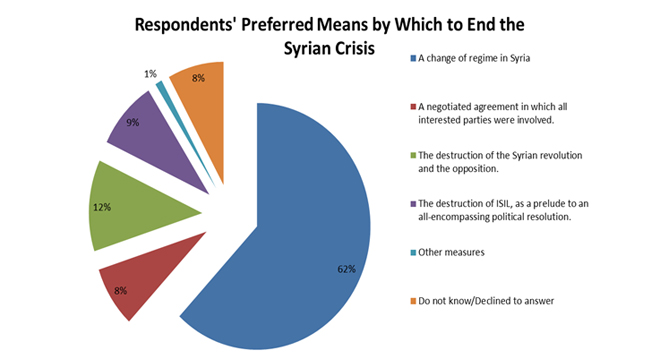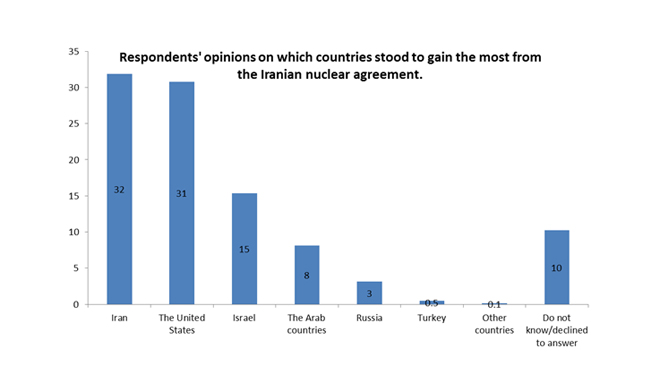One of the over-arching political grievances in the Arab world over the past five years has been the continued suffering of the Syrian people. In fact, “sectarian tensions in Iraq and Syria” were cited by more than one fifth of respondents as a main factor which contributed to the rise of ISIL.
Results show that no consensus exists among the Arab people over the best measures by which to combat ISIL and armed terrorist groups in general. This reflects both the complexity of the issue and the sophisticated attitudes of the Arab public towards it. Respondents cited different measures as the most important in combatting ISIL, including: supporting democratic transition in the region (28%); resolving the Palestinian cause (18%); ending foreign intervention (14%); intensifying the military campaign against ISIL (14%); and solving the Syrian crisis in line with the aspirations of the Syrian people (12%) would effectively end the threat of terrorism.
In line with previous polls within the Arab Opinion Index, this year’s results show that a majority (62%) of the Arab public views a change in the Syrian regime as the ideal means by which to end the Syrian crisis. In other words, and comparing these findings to previous opinion polls, the Arab public at large remains sympathetic to the aims and objectives of the Syrian revolution.

In parallel to the Syrian crisis, attention in the Arab world has also been sharply focused on negotiations covering Iran’s nuclear energy program, and its ability to arrive at an agreement with a group of important world powers (the permanent five members of the UN Security Council in addition to Germany). Since 2011, there has been increased desire among the Arab public for the Middle East to be declared a nuclear weapons-free zone, yet many respondents agreed that Israel’s possession of nuclear weapons justified attempts by other regional powers to acquire such weapons. While the Iranian nuclear program has a stated aim which is limited to the production of nuclear energy for peaceful purposes, the rising opposition to nuclear weapons in the Middle East is undoubtedly related to the negotiations which preceded the Iranian nuclear agreement, and Iran’s involvement in the affairs of Arab countries in the greater Levant has also heightened this interest. In fact, more Arabs believe that Israel will benefit from the Iranian nuclear agreement than believe that the Arab states stand to gain by the rapprochement between Tehran and the West.
Results show a divided Arab public opinion regarding the Iranian nuclear deal: 40% of the respondents support it and 32% oppose it. Their opinions are largely based on their assessment of Iranian policies in the region. Thirty-one percent of the respondents formed their supporting or opposing opinion regarding the nuclear deal based on their opposition to Iran’s interference in the affairs of some Arab states, in a manner that has threatened the national security of those states. However, 16% of the respondents opposed the Iranian nuclear deal based on their view that the deal represents a submission on Iran’s part to the United States and hence benefits Israel.

The results of the Arab Opinion Index showed that 34% of the public views the Arab revolutions and the Arab Spring as positive developments, while 59% expressed a negative view. Those whose views of the Arab revolutions’ developments were negative explained their positions in reference to the large-scale human losses; the spread of discord and chaos and lack of security; the collapse of states and state institutions; and instability more broadly. Only 5% of those who have negative views of the Arab revolutions based their opinion on general opposition to revolutions. The results are, in fact, an assessment of the developments that followed the Arab Spring revolutions of 2011.
Arab citizens are still optimistic regarding the future of Arab revolutions which started in 2011: 48% of respondents believe the Arab Spring is facing a series of challenges and obstacles, but will ultimately succeed in achieving its aims. However, 34% believe the Arab Spring has ended and the old regimes have returned to power. The main stated reasons for the obstruction of the Arab Spring: security deterioration in some states, economic hardship, foreign intervention, appearance of extremist organizations, incitement by previous regimes and incitement by media outlets. The continuation of the state of chaos in some Arab countries as well as increased regime totalitarianism will lead to a reduction in optimism regarding the future of Arab revolutions.
Citizens in the Arab region have expressed their fears, to varying degrees, with regards to the rise of both Islamist and non-Islamic secular political movements. Fifty-seven percent of respondents expressed their fears towards Islamist political movements compared with 36% who said they have no fears. For secular political movements, 61% of respondents said they have fears towards them compared with 31% who said they have no fears.
Dr. Mohammad Almasri, Coordinator of the Arab Opinion Index who has supervised this survey, pointed out that, “The fact that large groups of Arab respondents fear the rise and ascendancy of both Islamist and non-Islamist/secular political movements is a reflection of the discord and disarray among Arab political movements and the partisanship and conflicts between Arab political movements.” This has created a lack of public confidence in Arab political movements. He added, “Respondents who have expressed their fears of both or one side have stated clear and specific reasons for that. Given these public attitudes, the lack of consensus between these two broad categories of political movements, and their inability to reduce public fear towards them, can be exploited by anti-democratic forces to agitate for a return to authoritarianism, and will therefore prove to be an obstacle on the path to democratization.”
The countries included within this year’s Arab Opinion Index are Algeria, Morocco, Tunisia, Mauritania, Egypt, Sudan, Palestine, Lebanon, Jordan, Iraq, Saudi Arabia and Kuwait. Together, they represent 90% of the population of the Arab League. Each of the country-specific samples were conducted using a randomized, self-weighted, multi-stage cluster method, providing margins of error of between 2% and 3%. To read the more extensive report, “The 2015 Arab Opinion Index: Results in Brief”, please click here or on the icon above.